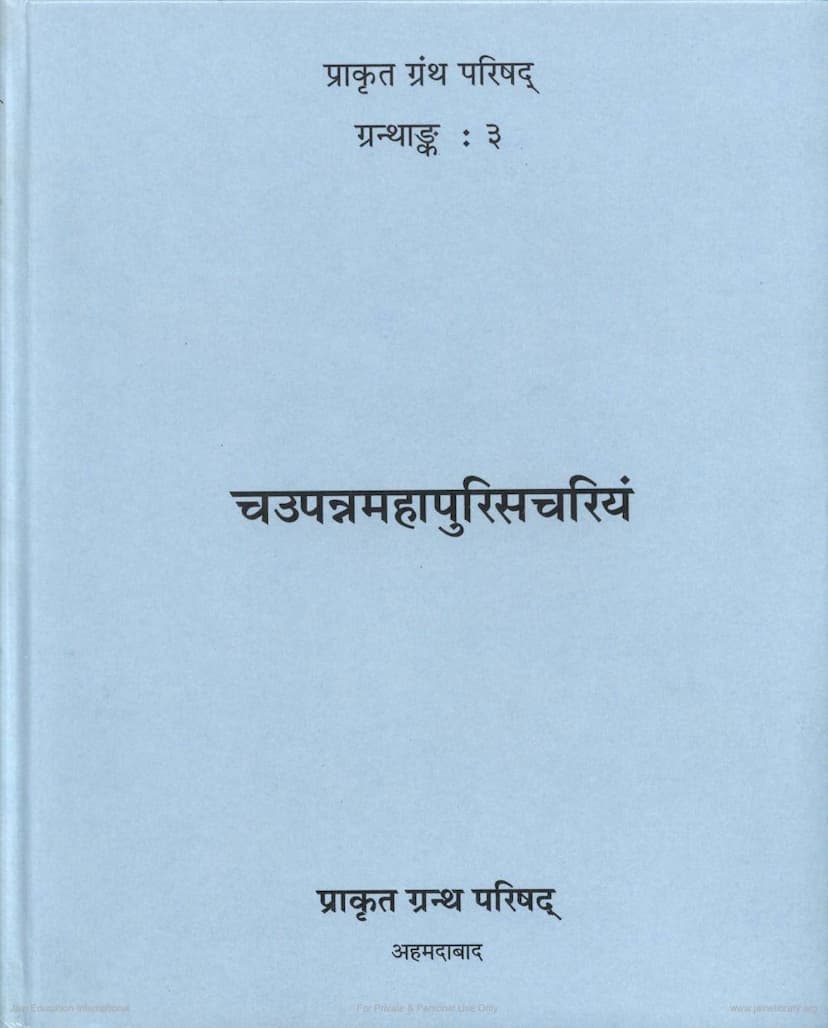Chaupannamahapurischariyam
Added to library: September 1, 2025

Summary
This Jain text, "Chaupannamahapurischariyam" (also transliterated as Cauppannamahāpurisacariam), is a significant work in Jain tradition, detailing the lives of 84 "great men" or mahāpuruṣas. Compiled and edited by esteemed scholars like Ācārya Śrī Śīlāṅka, Pt. Amritlal Mohanlal Bhojak, V.S. Agrawala, and Dal Sukh Malvania, and published by the Prakrit Text Society, Ahmedabad, this book is a treasure trove of Jain biographical and historical narratives.
Here's a comprehensive summary of its key aspects:
1. Title and Authorship:
- Title: Chaupannamahapurischariyam (or Caupanna Mahapurisa Cariyam)
- Author: Ācārya Śrī Śīlāṅka (also known as Śīlānkācārya)
- Editors/Compilers: Pt. Amritlal Mohanlal Bhojak (Chief Editor), V.S. Agrawala, and Dal Sukh Malvania (General Editors)
- Publisher: Prakrit Text Society, Ahmedabad
- Year of Publication: Reprint in November 2006 (Original publication possibly earlier, with the preface dated February 10, 1961, by General Editors Vasudeva S. Agrawala and Dalsukh Malvania).
2. Subject Matter: The book's primary subject is the lives of the 54 great souls revered in Jainism. These are categorized as:
- 24 Tirthankaras (spiritual guides who appear in each epoch).
- 12 Chakravartins (universal emperors).
- 9 Baladevas (great heroes of virtuous strength).
- 9 Vasudevas (powerful figures associated with the Baladevas, often in conflict).
- 9 Prativāsudevas (antagonists to Vasudevas).
These figures are collectively known as Śalākāpuruṣas (men marked by a particular sign or characteristic). The text provides biographical accounts of these 54 (or 63, if Prativāsudevas are included) prominent individuals, detailing their lives, virtuous deeds, spiritual journeys, and eventual liberation (moksha).
3. Significance and Context:
- Universal History: The Chaupannamahapurischariyam presents a Jain perspective on universal history, tracing the lineage of these significant souls across different epochs and their role in the unfolding of time according to Jain cosmology.
- Literary and Scholarly Value: The text is important for understanding Jain religious literature, historical narratives, and the evolution of Prakrit language and literature. It offers a unique perspective, often contrasting with or complementing accounts found in other Indian religious traditions.
- Source for Study: The work is a critical source for scholars studying Jainism, Indian history, cultural traditions, and the development of Indo-Aryan languages. The introduction by Klaus Bruhn highlights its value as an independent source for the study of Jain universal history.
4. Structure and Content Details (from Introduction and Table of Contents): The Chaupannamahapurischariyam is structured into various sections and contains several appendices that enhance its scholarly utility:
- Biographical Narratives: The core of the work consists of the life stories of the 54 (or 63) mahāpuruṣas. The text meticulously details their births, previous lives (pūrva-bhava), renunciations, spiritual pursuits, achievements, and final liberation.
- Detailed Descriptions: The author, Śīlāṅka, provides rich details about the cultural milieu, including descriptions of cities, rituals, societal norms, ethical teachings, and even specific stories that illustrate moral principles.
- Unique Elements: The introduction by Klaus Bruhn points out that Śīlāṅka's work includes unique elements such as a Sanskrit drama (Vibudhānanda) and three vairāgya-stories (stories of renunciation) that are not found in other versions of the Universal History. There's also mention of a parable related by Mahavira that is peculiar to this text.
- Linguistic Features: The text is written in Prakrit, with some Sanskrit and Apabhramsa elements, making it valuable for linguistic studies. The editors have noted the use of "deshya" (local) Prakrit words and provided a collection of them in the appendices.
- Appendices: The book is supplemented by eight appendices that are crucial for research:
- Index of Proper Names (alphabetical)
- Classification of Proper Names (by category)
- Collection of Deshya-Prakrit words
- Collection of Apabhramsa verses
- Collection of descriptive passages (e.g., descriptions of seasons, battles, processions)
- Hymns of praise (stutis) and salutations (vandanā) to deities and Tirthankaras.
- Collection of 668 subhāṣita-gāthās (wise verses) with subject and location indices.
- Collection of proverbs and idioms.
- Critical Edition: The work is presented as a critical edition, based on multiple manuscripts, with detailed notes and textual comparisons, particularly highlighting variations between the "Sū" and "Je" manuscripts mentioned in the preface.
5. Author's Style and Approach:
- Psychological Motivation: Dr. Bruhn notes that Śīlāṅka's style often focuses on the psychological motivation behind the characters' actions and decisions.
- Narrative Depth: While comparing Śīlāṅka's work with Hemacandra's Triṣaṣṭiśalākāpuruṣacaritra (HTr), it's observed that Śīlāṅka's treatment can be more condensed in some areas but also more exhaustive in others, particularly regarding philosophical discussions and detailed descriptions.
6. Historical and Cultural Insights: The text offers glimpses into the socio-cultural landscape of ancient India, including:
- Religious Practices: References to worship of deities, the importance of Tirthankaras, and philosophical discussions.
- Social Customs: Mention of practices related to marriage, family life, and social hierarchy.
- Arts and Sciences: Inclusion of aspects like music, drama, calligraphy, and various disciplines of knowledge.
- Linguistic Material: The use of diverse Prakrit dialects and Apabhramsa provides valuable linguistic data.
7. Comparison with Other Works: The introduction and appendices often compare the narratives and linguistic features of this text with other Jain works like Hemacandra's Triṣaṣṭiśalākāpuruṣacaritra, Vasudevahiṇḍi, and canonical texts. This comparative approach helps trace the development and transmission of Jain legends.
In summary, Chaupannamahapurischariyam is a comprehensive and scholarly work that serves as a vital repository of Jain tradition, offering detailed biographies of its most revered figures, insights into its philosophical underpinnings, and a rich tapestry of ancient Indian culture, all preserved in the Prakrit language.